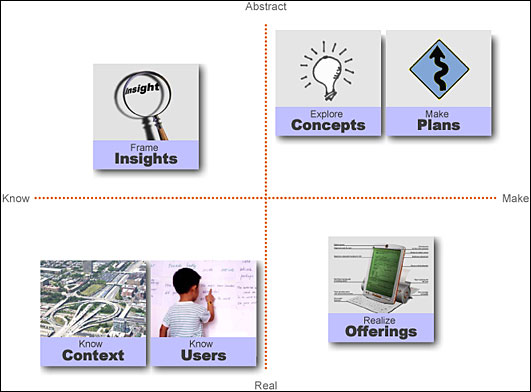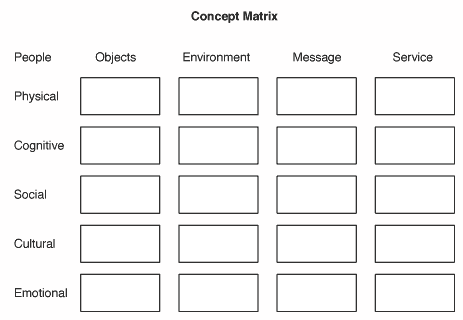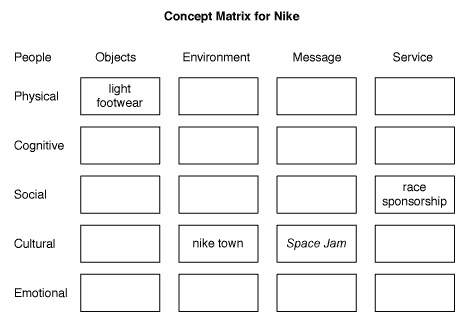October 26, 2003
About With and For Part 2: Vijay's Talk
The meat of the conference were eight presentations given by various design professionals. Unfortunately, there were only two time slots, which means four talks took place concurrently. Choosing was not easy.
The first session I went to was lead by Vijay Kumar, a professor at ID. I went because all of the ID students I met love him. They say he's a great, fun, smart, friendly teacher. From what I saw, I concur.
The other thing to know about Vijay is that he resides in a world of frameworks. He loves models. It seems he has not met a matrix he didn't like.
His talk, Insights to Innovations (not yet online), addressed the steps designers take to get from insights derived from research, to concepts that drive new product ideas. Vijay has a delightfully simple two-by-two that represents the steps in a design process:

You start in the lower left-hand corner, getting to "know" the "real" - users and their contexts. Then you move up, abstracting from that knowledge to frame insights. Then you progress from knowing to making abstractions -- concepts and plans. And then you end up by producing something tangible. In a more standard framework, the quadrants would read, clockwise from lower left, Research, Analysis, Synthesis, and Implement.
I don't know how useful this framework is, but I'm a fan of it. A smart encapsulation of what we go through.
The bulk of Vijay's talk was about how we cross the threshold from insights to concepts. From analysis to synthesis. He claimed there are four modes for bridging this gap:
Criteria can be thought of simple noun phrases that emerge from an insight process. The classic example of this (and one which you'll hear ad nauseum if you spend any time at ID), are Oxo Good Grips. You can think of the Good Grips line as a series of physical properties -- large handles, rubber handles, ovoid shape (so they don't rotate in your hand), large clear type, etc. etc.-- that support ease of use for people with motor or perceptual challenges.
Principles are verb phrases that address are like sentences in a mission statement for the product. The example used came from a student project for a museum (the Museum of Science and Industry, I believe). From the research, the museum developed a set of principles: 1) Provide real and tailored visitor experiences, 2) Extend access to the museum experiences, 3) Foster a culture of innovation.
Frameworks are a bit more complex. They tend to be grids, matrices, any kind of system that identifies key attributes and highlights opportunities. One framework currently under development at ID is the Concept Matrix:

The Concept Matrix is known for it's POEMS mnemonic across the top. Down the left side are five factors of people. The matrix can be helpful to companies identify opportunities...

(Vijay had more stuff in boxes, but I didn't get it all down... I'm still not quite sure I buy the Concept Matrix...)
The last are scenarios, which might be the most basic. What stories can we tell, based on what we know about users and their contexts, that suggest ways of addressing their needs and desires? What are people's key factors and driving forces? What makes sense in terms of supporting those factors and forces? (I love the idea of writing as design method, and I just need to remember to do it more often.)
What I liked about Vijay's talk is it presented a series of ideas in a cogent fashion that allows someone like me to see "where I fit", and to consider, "Where could I go? What am I not taking advantage of?"
(Side thought on AIGA's Power of Design)
So, I'm reading these notes from various illustrious speakers, and all I can think is, "I'm sorry... Isn't this the same circle jerk the "design profession" has been engaged in for the past... 5, 10, 20 years?" "The Power of Design." "Design is All Around Us." "Design as Social Responsibility." etc. etc.
Okay. So I decided to strike-through that. It was a bit harsh, a toss-off based on initial thoughts. Not that I don't stand by it. But perhaps it's worth digging a little deeper.
I suppose my main problem is how the notes from presentations at The Power of Design seem to have come from the self-help section in a bookstore. Either it's the "Design is Everywhere" stuff, detailing just how essential design is in our lives, or it's the "Design Can Save the World" stuff, all about sustainability, and developing countries, and smart use of resources, or it's the "Design Is Not Doing Enough", a set of chastisements about how designers aren't living up to their potential in a world that needs them.
I suppose it would be less irritating if these were novel ideas -- but they seem to be the subject year in and year out. The profession of design can't help but discuss how glorious and essential it is, while bemoaning its underappreciation and underachievements.
I love working with designers -- they see the world in ways I don't. I just can't bear this incessant Big Picture Hand Wringing, which inevitably keeps me at arm's length from the "design profession." (And causes me to wonder if the AIGA are the appropriate stewards for Big D-Design.)
About With and For Part 1: A Great Conference
The IIT ID's About, With, and For conference was my second favorite conference experience this year, after the IA Summit.
The success of the conference was largely due to the focus of the topic -- methods for synthesizing user research to provide insights and concepts that lead to better product design. The specificity meant a deep look at what is perhaps *the* essential step in the user-centered design process. No matter how expert you were, you couldn't help but learn something new.
I missed the pre-conference workshops (I had to make my pilgrimage to Quimby's), but heard they went brilliantly. 6 different workshops took place simultaneously, each offering a different approach to synthesizing user research. In conversation afterward, Steve Portigal captured the experience as such, "It was like one of those comedy movies or television shows where you open the door and something that you didn't expect is happening. About half way in to the workshops, I visited each of them, and in one room you had people analyzing 30 sec videos, in another was a whiteboard session you'd expect at a consultancy, another featured arts-and-crafts with scissors and paper, in yet another a room was silent as people were writing their thoughts..." If nothing else it showed the remarkable range of approaches to making sense of what we observe.
The conference itself was a single day. I had the fortune of kicking it off with my talk, "Then a Miracle Occurs...", which I presaged in a prior peterme post, and which I'll write up more completely at some point in the future. The title comes from the following Sidney Harris cartoon:

Which for me, captures this notion that we get user data, and through some mechanations, produce something that directly informs the design. How do we do that?
[Note: I *just* now discovered that my business partner Jesse James Garrett uses the same cartoon to illustrate a similar, but different, point in his rumination on the practice of information architecture.]
A later presentation by Michael Winnick, a student at ID, labelled a similar mystery in the product design process. How we get from business requirements (often captured in a marketing requirements document) to a spec. He labelled the void in between as "Terra Incognita," which made me think of unchartered waters. If I give my keynote talk again, maybe instead of the cartoon, I'll do up some cartography with "here be dragons."

